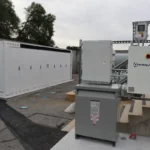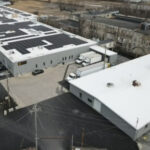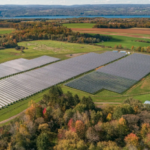We hosted a webinar recently entitled “Modeling the Economics Residential Energy Storage Projects in California” where we shared all of our latest insights on the market. We’re constantly learning and adjusting our thinking as the market evolves. We’re fortunate to have a front-row seat, working closely with many of the leading (ESS) Energy Storage System equipment vendors and project developers in California. Here are our top 6 big-picture thoughts on the current state of the residential storage market in California:
1.) Demand is strong and projected to continue growing rapidly
Market data definitively shows that residential storage deployments in California are growing rapidly. The Smart Electric Power Alliance recently published the 2019 Energy Storage Market Snapshot report, which reported 175.5 MWh’s of residential storage capacity added in 2018, which was an increase of 500% compared to 2017 levels. In California alone, the report counted 99.9 MWh’s of residential storage interconnected in 2018, an increase of 629% vs 2017 levels.
Wood Mackenzie’s Q2 2019 U.S. Energy Storage Monitor report also ranked California as the top state for residential storage deployments for 2018 and also Q1 of 2019. The report forecasts strong continued growth in the residential segment over the next 5 years, with annual MW storage deployments expected to more than double in 2020 vs 2019. Looking out over the next 5 years they forecast residential deployments to grow by over 5x in 2024 vs 2019 projections.
The current allotment of residential (SGIP) Self-Generation Incentive Program dollars is virtually gone. SDG&E exhausted their residential budget over a year ago, PG&E recently opened step 5 of 5 in early July and less than 3 weeks later the money was all reserved. SCE is currently in step 5 of 5. Meanwhile, on the commercial side, SDG&E, PG&E and SCE are still in step 2 or 3 of 5 for SGIP. The good news for residential storage developers is that the SGIP budget is scheduled to get a huge replenishment soon thanks to Senate Bill 700 which passed the California legislature last year.
2.) California has the best TOU rates for Residential ESS economics in the country
We’ve evaluated residential (TOU) time-of-use rates in every state and California’s are the most advantageous for energy storage economics in the country. This is especially relevant given that all new solar customers in the big 3 (IOU) investor-owned utility territories in California are now required to take service on a TOU rate after going solar, which was mandated in the big NEM 2.0 ruling in 2016.
All 3 IOU’s have now transitioned to TOU rates that feature a later evening “on-peak” period (i.e. 4 pm to 9 pm). This enables ESS to capture value by charging from mid-day solar in a cheaper “off-peak” or “mid-peak” period and then discharge back to reduce a homeowner’s load during the premium “on-peak” window. The most advantageous PV+ESS rate schedules offer a wide price differential year-round. Solar homeowners in California now have multiple rate schedule options to choose from. SDG&E and SCE currently offer customers 4 TOU rate options, and PG&E offers 3. In our webinar we identified the best available TOU rate schedule option in each IOU territory for PV+ESS economics:
- SCE: TOU-D-PRIME
- SDG&E: DR-SES
- PG&E: EV2 (which recently replaced PG&E’s EV(A) schedule on 7/1/19)
3.) PV-only project economics still beats PV+ESS project economics
We published an article in SolarPowerWorld in March which presented a case study comparing PV-only versus PV+ESS economics on SCE’s new TOU-D-PRIME residential rate schedule. We concluded that using reasonable market rate assumptions, PV+ESS beat PV-only on the TOU-D-PRIME rate, on both a payback period and (IRR) internal rate of return basis. Note: we peer-reviewed our analysis with numerous parties, including SCE and completely stand behind our conclusion.
But the shortcoming of that analysis is that it studied PV-only project economics versus PV+ESS project economics on the same rate schedule. On our webinar we discussed the fact that the most appropriate comparison salespeople should perform is to compare PV-only economics on the best PV-only rate, versus PV+ESS economics on the best PV+ESS. For example, in SCE the TOU-D-4P-9P rate schedule is most optimal for PV-only, whereas the TOU-D-PRIME rate is most optimal for PV+ESS.
When we perform this “best rate vs best rate” comparison in all 3 IOU territories, using reasonable market rate assumptions for both PV and ESS installation costs, PV-only still consistently beats PV+ESS. This effectively means that adding ESS to a PV project weakens the financial return, reducing both the payback period and IRR.
4.) Primary motivation for homeowners adding ESS today is not financial
Given that point #1 is true: residential storage deployments are growing rapidly. And point #3 is also true: adding ESS to a PV project weakens the economic value proposition. Point #4 must, therefore, be true: the primary motivation for homeowners adding storage today is not financial.
Leading residential ESS vendors and installers are well-aware of this fact. They know that most ESS systems today are being bought and sold based on the promise of back-up power and increased energy independence from the utility company. Leading residential ESS vendors and installation companies prominently feature these value propositions in their messaging and marketing materials. Additionally, a lot of homeowners who’ve already installed ESS are early adopter types that value owning a technology that will one day revolutionize the grid. So even though California has advantageous TOU rate schedules to save money with ESS, it’s not the primary value proposition being sold today.
5.) Adding Energy Storage adds complexity to the sale
Many of the leading residential solar developers in California have selling projects down to a science. It’s not uncommon for a top residential solar salesperson in California to sell over 20 projects a month, which is about one system per business day. In many cases, a solar salesperson can close a PV-only deal in one customer meeting. The reason why is that solar makes strong financial sense for most homeowners in California, in many cases it’s a no brainer. Even though the IOU’s new TOU rates that have later evening “on-peak” periods are eroding the value of solar, the bottom-line is that solar only economics are still very attractive.
Adding energy storage to a solar project adds a layer of complexity. It likely lengthens the sales cycle, because it’s another thing for the salesperson to explain. A homeowner may ask more questions about storage because it doesn’t have as proven a track record as solar does yet. The sales pitch for solar only is straightforward and repeatable: it will reduce your electric bill and offer a strong financial return. But the pitch for selling ESS depends on the specific motivation of the homeowner. Are they in a location where they have grid outages and do they value back-up power? Do they value being more energy independent and less reliant on the local utility company? Are they an early-adopter type or motivated more by financials?
6.) NEM 3.0 will change everything
I predict that Net Metering version 3.0 in California will dramatically reduce the value of exported solar production to the grid. This will completely reshape the economics of pairing energy storage with solar. In a NEM 3.0 world, adding storage may be a prerequisite for a residential solar project to pencil out. Especially for large 100% offset solar PV systems, which typically export more than 50% their production to the grid.
This is effectively how the Hawaiian residential market has evolved. Hawaii has the highest retail electricity rates in the country, which made the economics of residential solar very attractive. This created large demand and quickly led to high penetration levels of customer-sited solar on Hawaii’s grid. This led regulators to significantly reduce the export rate when Hawaii sunsetted their NEM program in 2015 and introduced successor tariffs. Today, Hawaii has very high storage attachment rates. Homeowners effectively need to pair storage with solar to prevent exports and make the project economically viable.
The expected timeline for NEM 3.0 in California is unclear at this point. Background preparation work by utilities and parties to the big looming NEM 3.0 proceeding have already begun. CALSSA (California Solar and Storage Association) believes that formal proposals will likely be solicited early in 2020, with the possibility of a decision by late 2020, and the new NEM 3.0 rules taking effect sometime in 2021. Two years in the solar world is not far away.
Check out the webinar we hosted here.



